Korean Random Chess
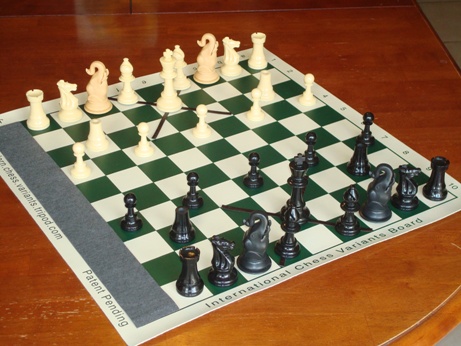
My 'Western' rendition of a Changgi board (above) and my Traditional Korean Chess set (below).
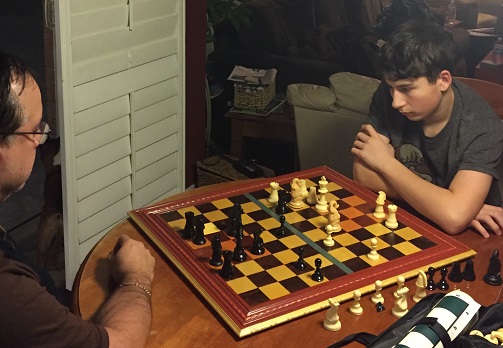
My son Joseph and I playing KRC on my homemade Xiangqi Cambaluc board. (Dec 28, 2017)
It is widely accepted that Korean Chess derives from an old variety of Chinese Chess. But in MY humble opinion (from my western point of view), Korean Chess (Changgi or Janggi) is actually an improved version of Chinese Chess (Xiangqi).
Korean Chess has the following features which I consider enhancements:
- Improved movement of the Chinese Elephant (an old Chaturanga Alfil, limited to defend on only half of the board)
- No river, which automatically improves the attacking capabilities of the Pawns (Soldiers) and Elephants
- Improved movement for the King (General) and the Guards within the Palace.
- A selective degree of randomness, as players are allowed to swap the places of the Knights and Elephants before their first turn.
Initial setup for Rook and Elephants for North Korean Chess
... along with a couple of rule changes of my own, to complete my westernized random Korean Chess variation.
The Pope in Rome has Swiss Guards; in Korean Random Chess (KRC), Kings are protected by powerful Samurai Guards inside their palaces, and also outside!
KRC introduces Guards that can exit outside of their King's Palace and the Banzai tactic to the world of Oriental based chess variants.
In addition to the Japanese Samurai and "Banzai" tactic, KRC also features Pawns that promote to any friendly piece (including Samurai Guards ) that has been captured, and for which they must be exchanged, upon reaching the 10th rank. This new rule was adopted in 2016.
In my 'Western' rendition of a Changgi board above, for the Palace I'm using vynil strips (cut from a placemat just placed [not glued] on the board), Seirawan Elephants for the Elephants, Orthodox Bishops as the Samurai Guards, and homemade Cannons.
For the Cannons I used drilled beheaded Rooks (I used the Rook tops to glue on Knights to make Chancellors).
Jose Carrillo, Ajax, Ontario, Canada - October 7, 2009
Setup

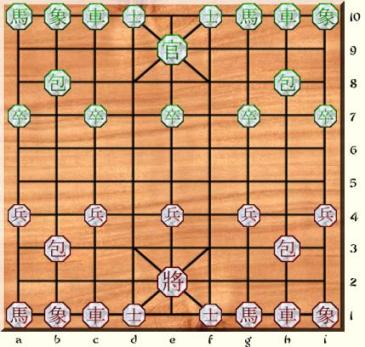
The initial position in the first row for the Rooks, Elephants and Knights is totally random, with the only restriction that you have one piece of each type at both sides of the King. There is direct symmetry accross the board for both armies.
There are 36 possible random setups in Korean Random Chess.
The initial position for the King, Samurai Guards, Pawns and Cannons is the same as in Korean Chess.
The only purpose of the diagonal lines in the Palace is to show the Palace boundaries. For all purposes the Palace can be defined by a just marking the outside boundaries of the Palace (see the Cambaluc board below). In Korean Random Chess the diagonal lines do not extend the movements of the Rook, Cannon or Pawns within the castle.
Korean Random Chess can be played with a variety of character sets and boards.
Here are two Chinese Chess board setups, one with Chinese Characters and one with Western Chess pieces on a Cambaluc board:
Remember that when using Chinese boards, the River must be ignored.
Pieces
The Korean Random Chess pieces take their more western common names:- King (instead of General [Han (red/white) / Cho (green/blue/black)])
- Rook (instead of Chariot [Cha])
- Knight (instead of Horse [Ma])
- Pawn (instead of Soldier [Pyong (red/white) / Chol (green/blue/black)])
- Cannons [Po], Guards [Sa] and Elephants [Sang] keep their equivalent Korean names.
Piece Movements
Rooks, Cannons, Elephants, Knights and Pawns keep their traditional Korean movement; with the exception that Rooks, Cannons and Pawns can not move on the diagonal lines within the Palace (the lines in the Palace are meaningless with regard to piece movements).The Rook moves exactly the same as in Orthodox Chess. It moves in a straight line horizontally or vertically across any number of empty spaces, stopping either on an empty space or the first space it comes to that is occupied by one of the opponent's pieces. It may not pass over occupied spaces.
The Knight first moves one space orthogonally followed by one more space diagonally outward. When the first space it would move over is occupied, its movement in that direction is blocked.
The Elephant is like a giant Horse. It moves 3 positions away from itself: first by going one step horizontally or vertically and then TWO outward diagonal steps and there must be clear passage.
Just like in Korean Chess, Cannons must jump a piece in order to move; but Cannons can not jump over Cannons, nor can they capture enemy Cannons. Therefore (unlike in Chinese Chess), a double Cannon lineup against a King poses no immediate threat, as the rear Cannon can't jump over the front Cannon.
Pawns move the same way they capture: they can move either one step forward or one step sideways. They can never move backward. If a Pawn makes it to the last row, it must promote and be exchanged by a friendly piece (including Samurai Guards) that has been previously captured. This new pawn promotion rule is inspired by a similar rule from the Changgi Association Tokyo Branch.
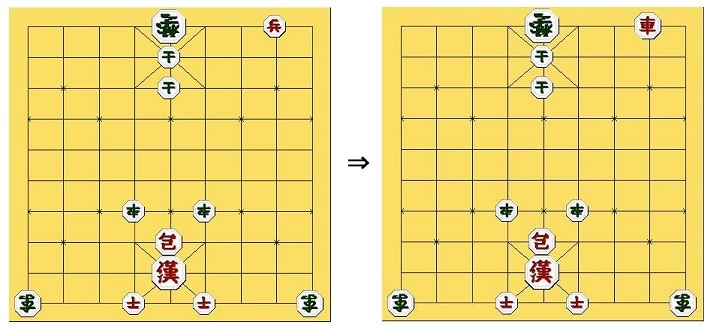
In the example above, the pawn at h10 promotes into a Rook.
The King in Korean Random Chess moves just like an Orthodox Chess King, one step in any direction orthogonally or diagonally, regardless of whether there is a line or not showing the path within the Palace, which is different than in Korean Chess. Kings can not move outside of their Palaces.
The two enemy Kings can NEVER face each other naked (without any pieces between them) on an open file at any time, just like in Chinese Chess.
The traditional Korean Chess rule allowing Kings to place the other King in check in a desperate last-chance move to irreversably foresake the right to checkmate the other side (hoping for a stalemate) does NOT apply to Korean Random Chess.
Korean Random Chess features Samurai Guards, which also move just like an Orthodox Chess King, one step in any direction orthogonally or diagonally (like a Courier Chess Man or Commoner). But a novelty in Korean Random Chess is that the Samurai Guards DO have the ability of getting out of the Palace. Therefore these Guards can be used both defensively (within the Palace) or offensively (outside of the Castle).
The only catch is that when Samurai Guards are outside of the Palace, they must take (or kill) the enemy upon first contact (similar to how Checkers men are obliged to jump when possible and capture). Should a Samurai Guard be in contact with more than one enemy piece (i.e. fork), the player may choose which of the attacked pieces to capture.
When a Samurai Guard is in a position where he must capture an opponent piece, the Guard is said to be in banzai.
In the opening and early in the middlegame (when there are still lots of pieces on the board), players should keep their Samurai Guards in defensive outposts inside or close to the Palace, as offensive Samurai Guards in banzai must capture even if the capture will cause the suicide of the Guard or will weaken his army's own defense.
Samurai Guards prove to be very powerful and efficient killers later on in the middlegame and endgame, when there are not too many pieces left on the board. A Guard and his King will easily be able to checkmate an opponent lonely King.
Samurai Guards are bound to the forced banzai attack rule when they are inside the opponent's palace. In this case the Guard's banzai capture may force him to come out of the opponent's palace.
Similar to calling 'check', calling 'banzai' to remind an opponent he is in a must take situation is optional. But should a player in banzai miss the situation and attempt to move without capturing with the Samurai Guard, or move a different piece altogether, then his opponent must call banzai as a reminder to the first player that he must take with his Guard.
The only exception to the Samurai Guard's banzai rule is when the Guard's capture might otherwise either:
- Cause their King to be in check, or
- Not protect a King already in check
- Doesn't expose their King to check, or
- Blocks the check threat
It is possible for Samurai Guards to be in banzai for consecutive turns, which could prove deadly to the Guard early in the game.
Players need to be well aware of the banzai tactic as the obligation to capture can be unfavorable to Samurai Guards outside their Palace. In some positions they may be forced by the enemy to capture to their disadvantage. Because of this risk, players should keep their Samurai Guards close to the Palace early in the game to avoid being forced into a banzai charge that may weaken their game.
Note that the squares one step away from the castle (c1, c2, c3, c4, d4, e4, f4, g1, g2, g3, g4 for one side; and c7, c8, c9, c10, d7, e7, f7, g7, g8, g9, g10 for the other) are now vulnerable to an attack from a Samurai Guard inside (on the outside perimeter of) the Palace!
Samurai Guards that have wondered outside of their own Palaces can return back inside. Once back inside their own Palace's, Guards no longer have the restriction that they must take upon close contact.
Below we ilustrate some Samurai Guard attack examples:
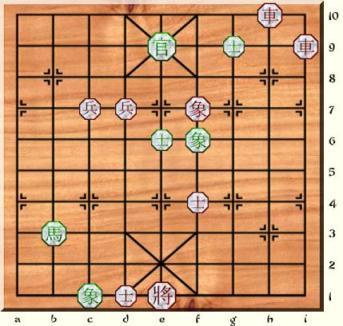
- Guard at f4: After Gf5, Red is forced to play Gxe6 or Gxf6 for his next move.
- Guard at f4: After Gg5, Red is forced to play Gxf6 for his next move.
- Guard at e6 is pinned (by the Red King): Green is not required to play Gxd7 or Gxf7, as this would put the Green King in check (by the Red King).
- Guard at e6 is pinned (by the Red King): Green may play Ge5. The Red Guard at f4 is now forced to play Gxe5, and now it would be the Red Guard at e5 the one pinned by the Green King.
- Guard at d1: Since the Guard is inside of the Palace, Red is not required to play Gxc1. Red though still has the option to capture with Gxc1 if he desires to.
- Guard at d1: Red can play Gc2 and fork both the Knight and the Elephant. Since the Guard is now outside of the palace, one of the two Green pieces will fall after Red's next forced move to capture (Gxc1 or Gxb3).
- Guard at d1: If Red plays Ge2 (this move by Red removes the pin on the Green e6-Guard), Green must now play Gxd7 or Gxf7 for his next move, as the Green King would now not be in check after his Guard's move.
- Guard at g9 is pinned (by the Red Rook at i9): Guard is not required to play Gxh10 as he would expose his King to check.
- Guard at g9 is pinned (by the Red Rook at i9): Guard may play Gf9 to get back into the Castle and get protection from his King.
Some real game play Samurai Guard examples:
Korean Random Chess / RNE-NER
Nicholas Wolff (USA) - Jose Carrillo (CAN)
CV Game Courier, October 2009
Position after 26...Gd9-c8 27. Rg4-e4+
Green's Guard threatens to take the Red Elephant at c7, but since the Green King is in check, Green is obliged to get out of check first.
Green actually played 27... Re9. Red played 28.Ef5 to protect his Elephant from the Guard and threaten the Green i3-Rook.
Korean Random Chess / NRE-NER
Nicholas Wolff (USA) - Jose Carrillo (CAN)
CV Game Courier, November 2009

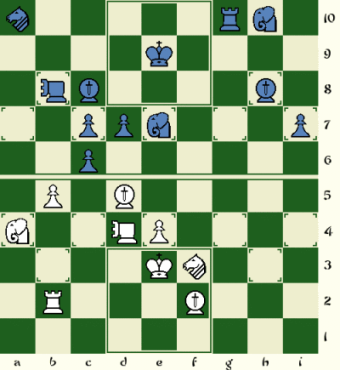
Left position above after 24... b-b6! (pinning the White b-Pawn to his Rook: for after 25.bxb6 or ba5 or bc5, 25... Cxb2 wins the White Rook)
Actually, Black sets up a trap! Black intends to play 25... bxb5 placing the Samurai Guard in banzai, forcing him to retake the b-Pawn, leaving the White Rook exposed to the Black Cannon's attack.
The position on the right above is after 25.Gd5? bc6!
White's Samurai Guard avoids the 1st trap, but falls for a 2nd trap. The b-Pawn move places the d-Guard in banzai and creates a discovered attack for the Black Cannon on the White Rook.
Now after 26.Gxc6 (banzai), ... Cxb2 wins the White Rook.
Then on the 27th move, the White Guard will still be in banzai! It will be forced to do a suicidal banzai charge further deteriorating White's game, as after the forced Gxc7 or Gxd7, the Black Guard on c8 will be in banzai himself and will be required to take the White Guard's life.
This position shows the risk of having Guards wondering outside of the Palace when there is still too many pieces on the board, as Guards may be forced to capture to their disadvantage.
Rules
Traditional check and checkmate rules apply.The goal of the game is to checkmate or stalemate the opponent's King. Stalemate is a loss for the side unable to move.
Just like in Chinese Chess, the two Kings can NEVER face each other naked (without any pieces between them) on an open file at any time.
The traditional Korean Chess rule allowing Kings to place the other King in check in a desperate last-chance move to irreversably foresake the right to checkmate the other side (hoping for a stalemate) does NOT apply to Korean Random Chess.
Draws are discouraged. Most games in Korean Random Chess end in a win for one side.
A player whose turn it is to move who has no move that does not worsen his/her position is in zugzwang, and he/she must play. Players are not allowed to pass in Korean Random Chess.
When a player is unable to legally move, but is not in check, the position is a stalemate and he/she loses the game.
Games are only drawn by mutual agreement when neither side feels they can force a checkmate, after 50-consecutive-moves without a capture or a forward Pawn-move (sideways Pawn-moves do not reset the 50-move count), or by insufficient material.
The only insufficient material situations that are automatic draws are lone King vs lone King, and lone King vs King & Cannons(1 or 2).
The spirit of the Chinese Chess rules regarding perpetual moves also apply to Korean Random Chess:
- Perpetual check is forbidden. You cannot check your opponent continually with the same piece (or pieces) repeating the same board positions over and over.
- You cannot force an enemy piece to move to and from the same two spaces, indefinitely.
- Korean Random Chess' Threefold Repetition rule: A player (the victim) who is being checked or whose pieces are being chased around can claim a WIN if the same position occurs three times, or will occur after their next move, with the same player to move. The repeated positions need not occur in succession.
- The purpose of the rules above is to avoid perpetual-move draws.
- The person forcing a perpetual move (the aggressor who is chasing a piece or giving the checks) must break off the repetitive sequence, or will risk losing the game by the KRC Threefold Repetition rule.
Korean Random Chess / ENR-ENR
Carlos Cetina (MEX) - Jose Carrillo (CAN)
CV Game Courier, February 2013
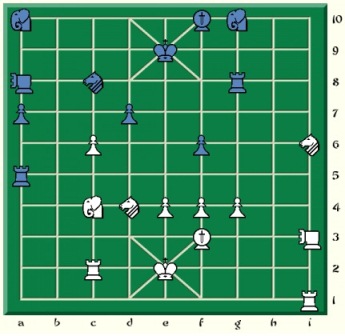
The position above, after: 26. ... Ra5 27.Ea1-c4(1), was repeated after: 27. ... Rc5 28.Eca1 Ra5 29.Eac4(2)
White currently has a slight advantage and a more solid position. Should the Black Rook (the aggressor) have continued to chase the White Elephant (the victim) back and forth between a1 and c4, after: 29. ... Rc5 30.Eca1 Ra5?? 31.Eac4(3); White would have won the game by the KRC Threefold Repetition rule.
Black played 29. ... Ege7 instead, to break the repetitive sequence and avoid a 3rd repetition of the postion above.
Bare King Checkmates and Stalemates
A King and any one piece (except a Cannon) are sufficient material to defeat a bare King (in the diagrams above imagine the position with the Kings with any one of the Red pieces on the board).
The King and a single Guard or Rook can checkmate (sample mates above left); while a King and Knight, Elephant or Pawn can win by stalemate (sample stalemates above right).
Sample Real Korean Random Chess Checkmates


Korean Triple Check (+++)
A very powerful, often mortal attack! It's really a double check by Rook and Cannon, where the Cannon is backed up by the King (or another Rook).After the removal of the Cannon, when the Rook is then supported by the King (or another Rook), Triple Checks often prove to be very lethal!
Korean Random Chess / NRE-RNE
Carlos Cetina (MEX) - Jose Carrillo (CAN)
CV Game Courier, January 2013

Left diagram after 9. ... Rd7-e7+++, a double check with the extra support from the King; diagram on right, two moves later after 10.Kd3 Ce8-e1!! (the Cannon has a fork on both White Rooks) 11.Gfxe1 Rd7# checkmate! Look at the important role of the Black King in the final position, on the original file of the triple check.
Sample Korean Random Chess Problems
- Left Position: Green wins. The Green Guard will hunt down the lonely Red Pawn, and then mate the Red King.
- Left Position: Without the Green Guard at e10, this position can be agreed as a draw, as neither side will likely be able to checkmate the other (Pawns can't go backwards to attack eachother).
- Right Position: Red plays and wins. After Nxh6 Red will have no trouble mating the Green King.
- Right Position: Green plays and draws. With Ee8, Red will be forced to take the Elephant with the wondering d7-Guard, and after Kxe8, neither side will have enough material to mate.
- Left Position: Red mates in 4 moves - 1.Ge7+ Kf9 2.Ke2 Ke9 3.Ge8+ Kf10 (or e10 or d10) 4.Ge9#
- Right Position: Red plays and wins - 1.e7 Ke9 2.Ke2
- 2...Kf9 3.e7 Kf10 4.e8 stalemate, Red wins!
- 2...Ke10 3.e8 Kf9 4.e9+ Kf8 (or Kf10) 5.Ke3 stalemate, Red wins!
Some Sample Complete Korean Random Chess Games
Korean Random Chess / RNE-NERNicholas Wolff (USA) - Jose Carrillo (CAN)
CV Game Courier, October 2009
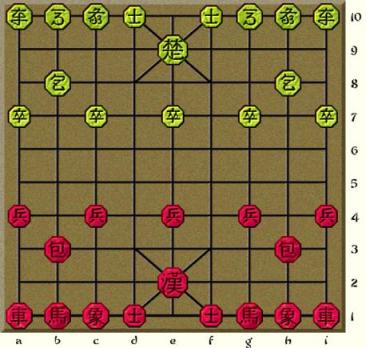

1.Nc3 Nf8 2.Cbe3 Che8 3.ab4 Nc8 4.ih4 Ehf7 5.Nf3 c6 6.Ehf4 gh7?! 7.Cxh7! Nxh7 8.Efh7+ Ke10 9.Ehe5 Nd6 10.ed4 Nf5 11.gf4 Nxh4 12.Cxe7? Ecxe7 13.Ne4? Cexe5+ 14.Kd3? Nxf3 15.Ri4 Nh2 16.Ri1 Nxf1 17.Rxf1 ih7 18.f5 Ri3+ 19. Kd2 Cee8 20.f6 Efi5 21.f7 Cexe4 22.Exe4 Eeg4+ 23.Rf4 Ra9? 24.Rxg4 Exf7 25.Ec7+ Gd9 26.Ra5 Gc8 27.Re4+ Re9 28.Ef5 Ri2+ 29.Ge2 Cd8+ 30.Exd8 Gxd8 (banzai) 31.Rxe9+ Gfxe9 32.Rxa7 Gf8 33.de4 Eh4 34.Rxh7? Rxe2+! 35.Kd3 Rxe4 36.Rh10+ Ke9 37.Rh9+ Gf9 38.Rh6 c5 39.Rc6 cxc4 40.bxc4 Gfe8 41.Rc5 Gdd7 42.Rc9+ Gd9 43.Rc5 Gd6 0-1
Korean Random Chess / NRE-NER
Nicholas Wolff (USA) - Jose Carrillo (CAN)
CV Game Courier, November 2009
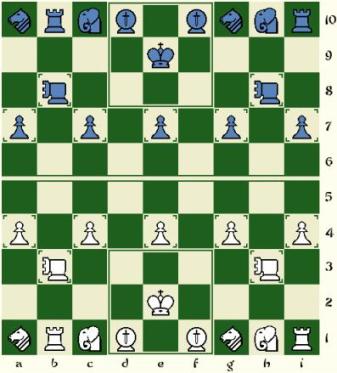
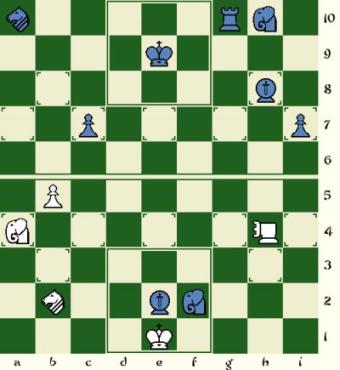
1.Nf3 Nf8 2.Cbg3 ih7 3.cd4 ab7 4.ab4 Ehf7 5.Ehe3 Che8 6.i5 ed7 7.Eca4 Efxd4! 8.Rb2 Ng6 9.Nc2 Edf7 10.Gd2?! Rxi5! 11.Rxi5 Nxi5 12.Chh8 Nxg4 13.Ncd4? Efxd4 14.Gd3 Edf7 15.b5 hi7?! 16.Cxg7 Gg9 17.Ng5 Gxh8 (banzai) 18.Cxg4 Efh10 19.Kd2 Cxe3 20.Kxe3 Ece7 21.Cd4 Gc9 22.Gf2 Rg10 23.Nf3 Gc8 24.Gc4 b6! 25.Gd5? bc6!! 26.Gxc6 (banzai) Cxb2 27.Gxd7 (banzai) Gxd7 (banzai) 28.Ne5 Eeh5+! 29.Kd3 Exf2 30.Ch4 Ge6 31.Nc4 Gd5 32.Nxb2 Gxe4+ (banzai) 33.Ke2 Ge3+ 34.Ke1 Ge2# 0-1
Korean Random Chess / ENR-NRE
Darren Paul (AUS) - Jose Carrillo (CAN)
CV Game Courier, December 2009

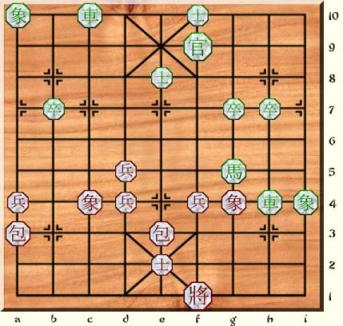
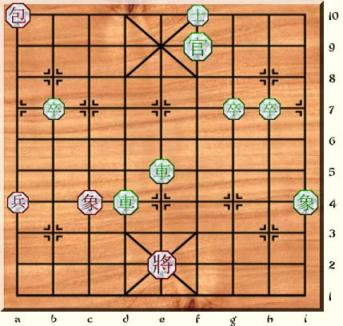
1.Nf3 Nf8 2.Che3 gh7 3.Cxe7? Cxh1 4.Nc3 Chh8 5.Cexa7 Che8+ 6.Cbe3 cb7 7.Caa3 Nc8 8.gf4 Eig7 9.cd4 Egxi4 10.Nd5 hg7 11.Nf6 Gd9 12.Nd7+ Kf9 13.Nxf8 Kxf8 14.Nh4? Rxh4 15.Rc5 Cbb1 16.Rf5+ Ke9 17.Eig4 Nd6 18.Re5 ih7 19.d5 Nf7 20.Rxe8+? Gxe8 21.ed4+ Kf9 22.Eac4 Cxf1 23.Kf1 Ng5 24.Ge2?? (middle diagram above) Rxg4? [Rh1#!!] 25.Gf3 Rg1+ 26.Ke2 Nxf3 27.Kxf3 Rf1+ 28.Ke2 Rxf4 29.Cee1 Rxd4 30.Cxe8 Re10 31.de5 Rxe8 32.Cxa10 Rxe5# 0-1
Korean Random Chess / NRE-RNE
Carlos Cetina (MEX) - Jose Carrillo (CAN)
CV Game Courier, January 2013



1.Ng3 Ng8 2.Eif3?! Che8 3.g5 ef7+ 4.ef4 Ece7+ 5.Kd2 Eexc4 6.Ece4 Gc9 7.Eexc7 Rd10+ 8.Ke2 Rd7 9.Ecxa10 Re7+++ 10.Kd3 Ce8-e1!! (middle diagram above) 11.Gfxe1 Rd7# 0-1
Korean Random Chess / ENR-ENR
Carlos Cetina (MEX) - Jose Carrillo (CAN)
CV Game Courier, February 2013

1.Ng3 Nc8 2.Che3 Cbe8 3.c5 Rb10 4.Gc2 ih7 5.Nc3 Ch2 6.Cbd3 Chxc2 7.Rxc2 g6 8.Nd5 cd7 9.Nf4 hh6 10.Cdxd10 Kxd10? 11.Cei3!! Ni8 12.ih4 hi6? {better: ... Cea8} 13.Nxg6 {+/=} Ke9 14.Nh8! Ri9 15.Nxi6 {+/-} Cea8! 16.Ng5 Ng7 17.Egi4 Rg9 18.Eixg7 Rxg7 19.Ni6 Rg8 20.Gf2 Cxa4 {+/=} 21.gf4 Rb6 22.c6 Rb5 23.Nf5 ef7 24.Gf3 Ca8 25.hg4 f6 26.Nd4 Ra5 27.Eac4(1) Rc5 28.Eca1 Ra5 29.Eac4(2) Ege7 {29. ... Rc5, 30.Eca1 Ra5??, 31.Eac4(3); 1-0 by threefold repetition} 30.Ecxe7 Nxe7 31.Rb2 Ead8 32.Cid3 Ri8? 33.Cxd7 {+/-} Ra2 34.Rxa2 Cxa2 35.Cd3 Ca10 36.cd6 Ca6 37.d7?! Cxi6! {+/=} 38.Kf2! Edg10 39.dxe7 Egxe7 40.Nc6 Eec10 41.ed4! ab7? 42.Re1+ Re8 (middle diagram above) 43.Nd8?? {first was: 43.Rxe8+!, then 44.Nd8 +/-} Rxe1! {=/+} 44.Nxc10+ Ke8 45.fe4 Rb1 46.gf4?! bc7! 47.Ge2 Rb10 48.Nd8 Cid6 49.d5 Cd10 50.ee5 Cd7! 51.d6 Cd4!! {52. ... Cxd7} 52.Ne6 fxe6 {-/+} 53.exe6 Rb6 54.fe4 Cd9 55.Ke3 Gf9 56.Gf3 Gf8 57.Gf4 Kf9?! 58.Cf3! Ci9 59.Cxf8 Kxf8 {=/+} 60.Ge5 Kf9 61.Gd5 Ce9 62.Kd3 Rb4 63.ed4 Ci9 64.Gc5 Rb3+ 65.Ke2 Rc3 66.Gb4?! Rc2+! 67.Kd3 Cc9!! {-/+} 68.Gb3 Rc1 69.Kd2 Rb1! 70.Ga3 Ci9 71.dc4 Cb9 72.Ga2 Rb5 73.Ga3 Ci9 74.Gb4!? Cd9+!! {-+, diagram above on right} 75.dc6 {any White King move, ... Re5#} cd7+ 76.ed6 dxd6+ 77.cd4 {again, any White King move, ... Re5#} dxc6+ 78.dc4 cd6+ 79.cd4 {once again, any White King move, ... Re5#} Rxb4 80.d5 Ke8 81.Kd3 dxd5# 0-1 (diagram below)

Notes
Game Courier Presets
Remember that at the start of the game the Rook, Knights and Elephants will be shuffled and placed randomly.Oriental Character Presets:
Preset 1 (The labels on the green pieces are all written in the Semi-cursive script)
Preset 2 (The labels for Rooks, Knights, Elephants and Cannons for both armies use the same set of Traditional characters)
Preset 3 (Chinese Chess characters)
Western Chess Figurine Presets:
Preset 4 (Korean Board)
Preset 5 (Cambaluc Chinese Chess Board)
Game Courier Logs
Game Courier Logs for Games of Korean Random ChessTo see actual games that have been played on-line, follow the link above.
Korean Random Chess (KRC) was created by Jose Manuel Carrillo-Muniz, from Puerto Rico in 2009.
Chess Variants by the Author:
- Modern Chess Complex
- Modern Random Chess (9x9)
- Contemporary Random Chess (8x8)
- Prime Ministers Chess (9x8)
- Pseudo-Modern Random Chess (9x9)
- Chess8400 (9x9)
- Prime Ministers Contemporary Random Chess (8x8)
- Prime Ministers Random Chess (9x8)
- Hia Chess (9x8)
- Modern Capablanca Random Chess (10x8)
- English Chess Complex
- Modern English Random Chess (10x10)
- International Contemporary Random Chess (10x10)
- International Fischer Random Chess (10x10)
- Courier Chess Complex
- Courier Chess Moderno (12x8)
- Mini Courier Chess Moderno (10x8)
- Silver Elephant Chess (10x8)
- Modern Ministers Courier Chess (11x8)
- Ajax Complex
- Ajax Chess (10x10)
- Ajax Orthodox Chess (8x8)
- Ajax Random Chess (8x8)
- Ajax Modern Random Chess (9x9)
- Ajax Ministers Chess (10x8)
- Ajax Falcon Chess (10x8)
- Ajax-Capablanca Chess (10x8)
- Ajax 3D Chess (8x8x3)
- Korean Random Chess (9x10)
- Latrunculi XXI & Petteia XXI (10x8)
- Partnership Chaturanga (8x8)
Other Presets by the Author:
- Chaturanga - Davidson Variation
- Modern Chess Preset
- Fischer Random Chess Preset
- Makruk (Thai Chess) Preset
- Ajax Xiangqi (9x10) proposed by Charles Gilman
- Ajax Bigamous Chess (9x8) by Carlos Cetina
- Ajax Euchess (10x10) by Carlos Cetina
- Frolov Chess - Ajax Variation (9x9)
- Hiashatar (Mongolian Decimal Chess) (10x10)
- Milenium 3D Chess (8x8x3) by William L. D'Agostino
Other Pages by the Author:
- How to Generate Random Positions
- The Bishop Adjustment Rule
- The Modern Principles
- Reverse Symmetry
- The Prime Minister
- The Courier Elephant
- The 10x8 Variants
- Checkers Variants
 This 'user submitted' page is a collaboration between the posting user and the Chess Variant Pages. Registered contributors to the Chess Variant Pages have the ability to post their own works, subject to review and editing by the Chess Variant Pages Editorial Staff.
This 'user submitted' page is a collaboration between the posting user and the Chess Variant Pages. Registered contributors to the Chess Variant Pages have the ability to post their own works, subject to review and editing by the Chess Variant Pages Editorial Staff.
By Jose Carrillo.
Web page created: 2009-10-09. Web page last updated: 2013-02-03